JARS v50n3 - Rhododendrons Propagated from Leaf Cuttings
Rhododendrons Propagated from Leaf Cuttings
Mieczyslaw Czekalski
Department of Ornamental Plants
Agricultural University
Poznan, Poland
There are various ways to propagate rhododendrons vegetatively. So far, the least successful way is by leaf cuttings (not to be confused with leaf-bud cuttings). There are only two reports on rooting rhododendron leaves. In a study by Custers (2), less than 25% of Rhododendron simsii (Planchon) leaves developed roots. Chaikin (1) wrote about a single leaf of R. 'Felicitas' which regenerated roots. In my previous trials (3) leaves of several rhododendron cultivars, including 'Cunningham's White', 'Catawbiense Grandiflorum', and 'Fastuosum Flore Pleno', successfully rooted. In none of the above cases, however, did rooted leaves develop into plants.
Not being discouraged by a partial success, I undertook another attempt to root leaves of these and other cultivars. In mid-October of 1992, I collected leaves without axillary buds from either 1-year-old containerized plants (Trial 1) or from over 30-year-old landscape plants (Trial 2). Leaves of various ages were sampled from the mature plants. Leaf petioles were treated with a Polish-made rooting stimulator (Ukorzeniacz AB), which contains IBA (0.05%), NAA (0.3%), and benomyl (0.1 %) in a powder form. A rooting medium was composed of peat, perlite, and sand (3:1:0.5; v:v:v) for Trial 1, and of peat and perlite (5:1; v:v) for Trial 2. Cuttings were inserted in the medium to a depth of 4 to 5 cm. Rooting took place in a greenhouse on electrically heated benches covered with plastic. The temperature of the medium was at 21°C in Trial 1 and 24°C in Trial 2. The rhododendron cultivars were: 'Catawbiense Grandiflorum', 'Cunningham's White', 'Fastuosum Flore Pleno', and 'Lee's Dark Purple' in Trial 1, and 'Album Novum', 'Kate Waterer', 'Nova Zembla' and 'Lee's Dark Purple' in Trial 2. Rooting was evaluated in June of 1993.
| Table 1. Number of rooted leaf cuttings and regenerated plants of several rhododendron cultivars. | ||||
|---|---|---|---|---|
Cultivar |
Leaf Age (years) |
Total Cuttings |
Rooted Cuttings |
Regenerated Plants |
Trial 1 (one-year-old Stock Plants) |
||||
'Catawbiense Grandiflorum' |
1 |
37 |
7 |
1 |
'Cunningham's White' |
1 |
42 |
25 |
0 |
'Fastuosum Flore Pleno' |
1 |
26 |
0 |
0 |
'Lee's Dark Purple' |
1 |
35 |
1 |
1 |
Trial 2 (30-year-old Stock Plants) |
||||
'Album Novum' |
1 |
28 |
0 |
0 |
2 |
28 |
1 |
0 |
|
3 |
31 |
0 |
0 |
|
'Kate Waterer' |
1 |
28 |
2 |
2 |
2 |
28 |
1 |
1 |
|
'Lee's Dark Purple' |
1 |
29 |
3 |
0 |
2 |
27 |
7 |
2 |
|
3 |
28 |
0 |
0 |
|
'Nova Zembla' |
1 |
27 |
3 |
0 |
2 |
29 |
0 |
0 |
|
3 |
28 |
0 |
0 |
|
In Trial 1, the R. 'Cunningham's White' leaves rooted best (Table 1). Of 42 cuttings of this cultivar, 25 (60%) regenerated roots, but none of them developed a stem. Two other cultivars, 'Catawbiense Grandiflorum' and 'Lee's Dark Purple', did not have such a high rooting rate, but each produced one plant from rooted leaves (Fig. 1 and Fig. 2). None of 26 R. 'Fastuosum Flore Pleno' leaves rooted.
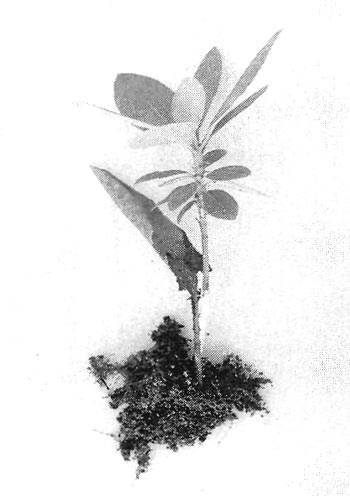
|
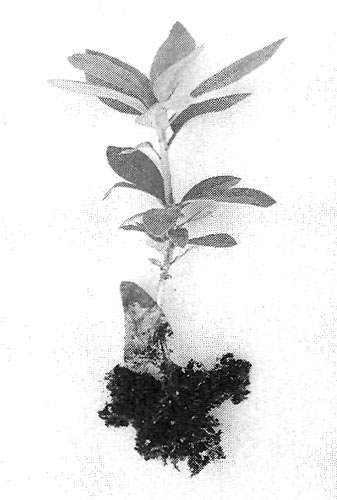
|
|
|---|---|---|
Fig 1. R. 'Catawbiense Grandiflorum' plant regenerated from a 1-yr-old leaf. |
Fig. 2. R. 'Lee's Dark Purple' plant regenerated from a 1 -year-old leaf. |
In Trial 2, 2-year-old leaves of R. 'Lee's Dark Purple' rooted better than leaves 1 or 3 years old (Table 1). Two-year-old leaves also produced two plants (Fig. 3), when younger and older leaves did not. In case of R. 'Kate Waterer', all three leaves that regenerated roots also developed stems (Fig. 4 and Fig. 5). Two other cultivars, 'Album Novum' and 'Nova Zembla', had few rooted cuttings, and none of them developed a stem.
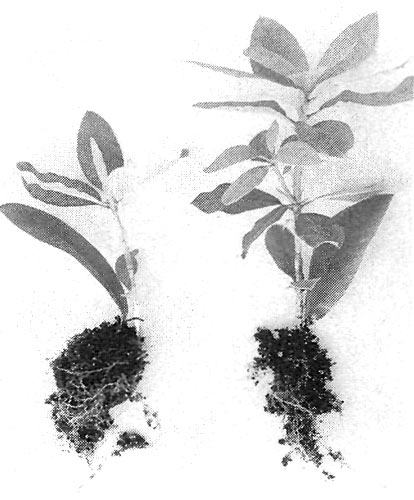
|
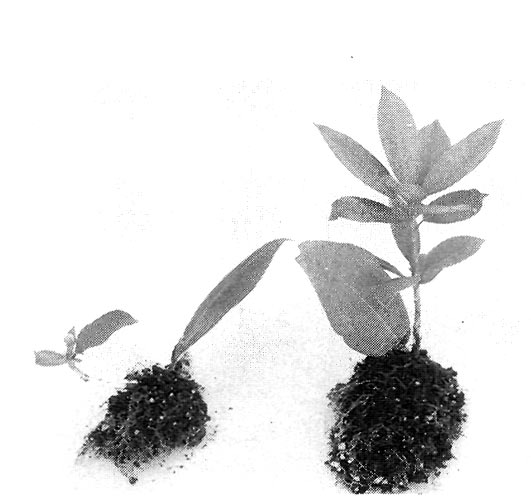
|
|
|---|---|---|
Fig. 3. R. 'Lee's Dark Purple' plants regenerated from 2-year-old leaves. |
Figure 4. R. 'Kate Waterer' plants regenerated from 1-year-old leaves. |
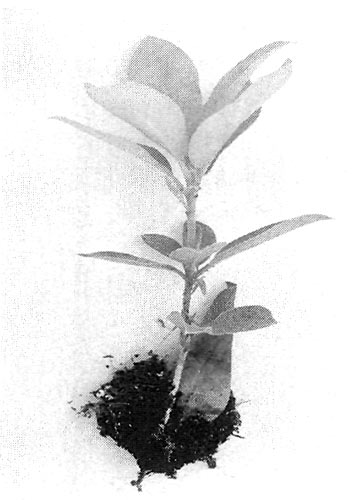
|
|---|
Fig. 5. R. 'Kate Waterer' plant regenerated from a 2-year-old leaf. |
These trials show that leaves of certain rhododendron cultivars are able to regenerate both roots and stems. Of the seven tested cultivars, three ('Kate Waterer', 'Lee's Dark Purple', and 'Catawbiense Grandiflorum'), produced plants from leaf cuttings. Obviously, the overall obtained efficiency (7 plants of total 451 leaf cuttings) is too small for this method to be used commercially. In addition, leaf cuttings take much longer time to regenerate roots and stems than stem cuttings. The first regenerated stem appeared above the surface of the medium 18 weeks after cuttings were inserted, and the last one 21 weeks later. Even so, these results reveal an exciting aspect of rhododendron biology: the ability of leaves to regenerate plants, which is rather unusual among woody plants. Also the "longevity" of rooted leaves is remarkable. After over 10 months spent on the propagation bench, they were still alive, with green and fresh looking leaf lamina. For most, only a part of the lamina inserted into the medium was decomposed, but even then the leaf petiole and central vein were functioning. In all seven cases of regeneration, stems appeared from the leaf petiole. Plants obtained from leaf cuttings were growing actively all summer long, produced two flushes of growth, and developed a strong root system. Today, they look very happy and seem to enjoy being my first rhododendrons from leaf cuttings.
Literature
1. Chaikin, R.W. Rooting rhododendron leaves. J. Amer. Rhod. Soc. 45(2):96; 1991.
2. Custers, J.B. Adventitious shoot formation on leaf cuttings in vivo, a tool in horticulture. Dept. Hort. Agric. Univ. Wageningen, The Netherlands, Pub. 528; 1986.
3. Czekalski, M. Propagation of evergreen rhododendrons by cuttings of six types. J. Amer. Rhod. Soc. 49(1); 40; 1995.
Professor Czekalski authored the article "Propagation of Evergreen Rhododendrons by Cuttings of Six Types" (Vol. 49, No. 1).

